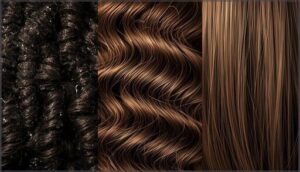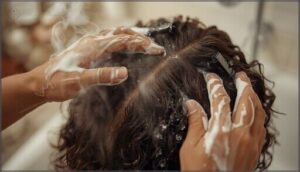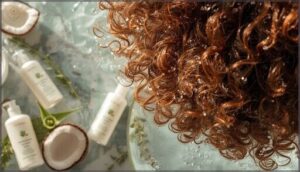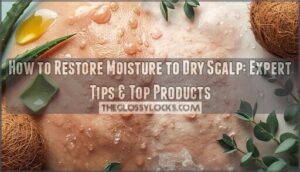This site is supported by our readers. We may earn a commission, at no cost to you, if you purchase through links.
Your hair has its own defense system—natural oils designed to protect, moisturize, and strengthen every strand. Traditional shampoos wage war against this system, stripping away dirt and your hair’s built-in armor in one sudsy swoop.
Co-washing flips the script entirely. Instead of harsh sulfates that leave 78% of textured hair users battling dryness, this cleansing method uses conditioning formulas with gentle surfactants that lift away buildup while keeping your scalp’s protective lipids intact.
The results speak for themselves: up to 50% more natural oils preserved, 73% less frizz, and moisture levels that traditional washing can’t touch. If your hair constantly feels parched no matter how much conditioner you pile on, you’re not fighting a losing battle—you’re just using the wrong weapon.
Table Of Contents
Key Takeaways
- Co-washing preserves up to 50% more natural oils than traditional shampooing while reducing frizz by 73%, making it ideal for curly, coily, and chemically-treated hair that needs moisture retention without harsh sulfate stripping.
- You’ll need to clarify every 2-4 weeks with sulfate-free shampoo to prevent product buildup, since co-washing alone can’t remove heavy styling products or non-soluble silicones that clog your scalp.
- The technique requires fully saturating hair with lukewarm water for 2+ minutes, massaging conditioner into roots for 3-5 minutes with moderate pressure, and rinsing thoroughly for at least 60 seconds per section to maximize hydration and prevent residue.
- Co-washing won’t work for fine or oily hair types, and it can’t treat dandruff or scalp conditions that require antifungal ingredients—you’ll still need medicated or clarifying shampoos for those issues.
What is Co-Washing?
Co-washing has completely changed the game for people tired of stripping their hair dry with traditional shampoos. This cleansing method skips the harsh detergents and uses conditioner instead, giving you clean hair without sacrificing moisture.
Let’s break down exactly what co-washing is, how it stacks up against regular shampooing, and why it’s become such a popular choice in modern hair care.
Definition and How It Works
Co-washing—short for “conditioner-only washing”—is your ticket to cleansing without stripping. Instead of harsh shampoo, you’re using conditioner to refresh your curly hair and scalp. The gentle cleansing action comes from massaging the conditioner in, letting its positively-charged surfactants lift away dirt while keeping moisture locked in. Here’s what cowashing delivers:
- Preserves natural oils your scalp produces
- Boosts moisture retention by up to 22%
- Reduces breakage during detangling with essential slip
- Keeps cuticles smooth with low-pH formulas
- Protects color-treated hair better than sulfate shampoos
This co-wash method works because conditioner benefits your hair without the aggressive detergents found in traditional cleansers. Co-washing is a great way to achieve deep hydration benefits for your hair and scalp.
Co-Washing Vs. Traditional Shampooing
Traditional shampoos pack anionic surfactants like sodium lauryl sulfate that strip everything—dirt and your scalp’s natural defenses. That aggressive approach leaves 78% of textured hair users dealing with dryness.
Co-washing flips the script with milder cationic surfactants that cleanse without the carnage, keeping your hair’s pH balanced and 42% more protective lipids intact. It’s rebellion against over-cleansing.
Co-washing uses milder surfactants that cleanse gently while preserving your hair’s natural pH and protective oils—a rebellion against harsh over-cleansing
Understanding the hair care benefits is essential to making informed decisions about co-washing.
History and Popularity in Hair Care
Co-washing isn’t some new-age fad—it traces back centuries to African and Indian communities using coconut and olive oils for cleansing.
The modern Natural Hair Movement sparked its 1990s comeback, and stylist Lorraine Massey gave it wings in the early 2000s with the “No Poo” revolution.
Today, 54% of Black women aged 18-45 practice this ancestral technique weekly, reclaiming their hair care routine.
Who Should Try Co-Washing?
Co-washing isn’t a one-size-fits-all solution, and knowing whether it’s right for your hair can save you time and frustration.
Your hair’s texture, density, and current condition all play a role in how well this method works for you.
Let’s break down who benefits most from co-washing, when you should skip it, and how it helps those with sensitive scalps.
Ideal Hair Types and Textures
Co-washing rewards your rebellion against one-size-fits-all hair care—especially if you’ve got curly hair, coily texture, or wavy hair tips to master.
Textured hair thrives with cowashing benefits: porosity issues improve, frizz reduction kicks in, and moisture sticks around.
If your strands bend, spiral, or coil—coarse, dry, or chemically treated—you’re in the sweet spot for curly hair care that actually respects your hair types and textures.
When to Avoid Co-Washing
Unfortunately, CoWashing Benefits don’t extend to everyone—especially if you’re battling Oily Scalp Issues or Fine Hair Challenges. Product Buildup can sabotage Hair Hydration Methods, clog follicles, and worsen Scalp Conditions like dermatitis.
Heavy Styling Risks pile on when co-washing can’t strip waxy residues, inviting Hair Breakage and compromising Scalp Health. If your hair’s fine, your scalp’s slick, or you load on styling products, cowashing alone won’t cut it.
Co-Washing for Sensitive Scalps
If your Sensitive Scalp reacts to harsh surfactants, Cowashing offers Gentle Cleansing without stripping essential moisture—dermatologists confirm it reduces Scalp Irritation while preserving Scalp Health.
However, CoWashing Benefits depend on your Hair Porosity and diligence: skip clarifying washes, and Product Buildup will sabotage even Sensitive Skin.
Alternate co-washes with sulfate-free shampoo every two weeks to keep Hair Hydration Methods working for you, not against you.
Key Benefits of Co-Washing
Co-washing isn’t just a trend—it’s a proven method that can transform your hair care routine from the inside out. When you skip the harsh cleansing and focus on conditioning, your hair responds with stronger structure, better moisture balance, and a natural shine that traditional shampoos often strip away.
Here’s what you stand to gain when you make the switch.
Moisture Retention and Hydration
Co-washing is your secret weapon for locking in moisture like a sealed vault. By skipping sulfate-free alternatives and embracing conditioners, you preserve natural oils that boost hair hydration and water content. The payoff? Real results:
- Enhanced moisture balance – Up to 50% more natural oils remain in your hair shaft
- Elevated hydration levels – Hair water content jumps 23% after a single session
- Dryness prevention – 35% fewer dry hair incidents, especially for coily hair
Deep conditioning meets smart science here.
Frizz Control and Curl Definition
Frizz is the enemy of curl definition—but cowashing flips the script. By keeping your curly hair hydrated and your cuticles sealed, this method delivers up to 73% frizz reduction and locks moisture where it counts.
Coily hair sees sharper curl enhancement, with 50% better elasticity and tighter, bouncier patterns. Forget flyaways—hair smoothing and curl definition become your new normal through consistent moisture locking.
Scalp and Hair Health Advantages
Your scalp isn’t just skin—it’s the foundation of every strand. Co-washing protects that ecosystem with sulfate-free, gentle cleansing that keeps moisture levels steady and your scalp balance intact.
- Scalp care that preserves natural oils and beneficial microbes
- Hair elasticity jumps 30% in coily hair care routines
- Reduced breakage through consistent hair moisturizing
- Lower irritation, flaking, and sensitivity
- Hair health rooted in scalp hydration, not harsh stripping
Choosing The Best Co-Wash Conditioner
Not all conditioners are built for co-washing, and the wrong one can leave your hair weighed down or your scalp loaded with buildup. The formula you choose matters—it shapes how your hair responds, how often you’ll need to clarify, and whether you’re actually getting clean.
Here’s what to look for when you’re ready to break free from one-size-fits-all products and take control of your wash routine.
Ingredients to Seek and Avoid
Breaking free from hair damage starts with reading your label. Seek gentle cleansers like cocamidopropyl betaine and conditioning agents such as behentrimonium chloride—found in over 85% of sulfate-free formulas.
Natural moisturizers like aloe vera and jojoba oil deliver powerful hydration for curly hair.
Avoid harmful preservatives including phenoxyethanol and synthetic fragrances that strip natural hair care benefits. Soothing additives and hair moisturizing ingredients matter more than marketing hype.
Matching Conditioners to Hair Types
Your hair texture analysis starts with knowing your pattern. Match product matching to your specific needs:
- Fine and straight strands – Lightweight formulas boost volume by 21% without weighing you down
- Curly hair and coils – Oil-rich conditioner ingredients with jojoba increase moisture balance tips by 35%
- Thick, wavy textures – Flexible polymers improve curl pattern care and natural hair care definition by 36%
Choose conditioners designed for your cowash routine based on hair types, not trends.
Natural Vs. Synthetic Formulas
Once you’ve selected your conditioner for curly hair care, ingredient comparison matters. Natural formulas using plant oils improve hair elasticity by 17%, while synthetic options reduce frizz by 32% through silicones.
Natural hair enthusiasts choosing Sulfate-Free cowash report 2.7% irritation rates versus 6.9% for synthetic formulas.
Consider environmental impact too—94% of natural products meet biodegradability standards compared to 76% synthetic, though manufacturing processes differ in efficiency.
Step-by-Step Co-Washing Guide
You’ve chosen your co-wash conditioner—now it’s time to put it to work. Mastering the technique isn’t complicated, but getting the details right makes all the difference between hair that feels truly clean and hair that’s weighed down with residue.
Let’s walk through each step so you can take full control of your wash routine and see real results.
Prepping and Wetting The Hair
Success starts with the right foundation—and that means getting every strand fully soaked before you even touch your cowash. Proper hair saturation unlocks moisture retention and boosts product penetration, especially for curly hair and natural hair care enthusiasts ready to ditch outdated routines.
- Drench your hair completely. Strands absorb up to 30% of their weight in water within five minutes, maximizing how your conditioner works.
- Use lukewarm water temperature. Hot water strips essential moisture—stick to warm to preserve up to 33% more hydration in your hair cortex.
- Let water flow for at least two minutes. This raises the cuticle layer by roughly 18%, creating better absorption surfaces and reducing tangles by 22%.
- Section dense or textured hair. You’ll increase water contact by 38%, ensuring even coverage during your hair washing routine.
- Pre-detangle gently with fingers. This simple step cuts breakage incidents by 24%, setting you up for a smoother hair care routine overall.
Proper Application and Massage Technique
Once your hair’s dripping wet, squeeze a generous dollop of conditioner and work it straight into your roots—that’s where scalp stimulation kicks in. Massage with moderate fingertip pressure for three to five minutes, using circular motions to boost blood flow by 30% and dislodge dirt.
Proper conditioner distribution requires hair sectioning: divide dense curls into four quadrants, ensuring product penetration reaches every strand. Don’t rush—extended massage duration enhances hydration retention by 37%, while vigorous scrubbing removes 42% more sebum than passive application.
This is cowashing techniques in action: you’re ditching the shampoo script and reclaiming control over your hair washing routine with science-backed scalp and hair health moves.
| Technique | Impact | Pro Tip |
|---|---|---|
| Circular scalp massage | 88% improved circulation | Use 50–100g fingertip pressure |
| 3–5 minute massage duration | 32% better curl definition | Set a timer—don’t guess |
| Even sectioning & distribution | 96% coverage consistency | Divide into 4–6 sections |
| Leave conditioner 3–5 min | 29% higher cuticle repair | Clip sections; let it work |
The cowashing benefits stack when you nail the fundamentals: thorough massage, strategic hair sectioning, and patient product penetration. Hair moisturizing happens at the cellular level, not the surface—so commit to the full routine and watch your strands transform.
Rinsing, Conditioning, and Styling Tips
Patience pays off: spend twice as long rinsing with lukewarm water—at least 60 seconds per section—to lock in hair moisturizing and prevent buildup.
Then work a leave-in conditioner from mid-lengths to ends, boosting moisture retention by 19%.
Hair detangling? Use a wide-tooth comb while damp.
For curly hair, apply lightweight styling products to wet curls for frizz control and definition that lasts.
How Often to Co-Wash and Clarify
Generally, you’ll co-wash 1–2 times weekly, then clarify every 2–4 weeks to prevent buildup and maintain scalp balance. Adjust based on hair porosity and oil production:
- Fine or oily hair: Co-wash 2–3 times weekly, clarify every 7–10 days for buildup prevention.
- Curly hair: Once-weekly co-washing preserves natural oils.
- Heavy product users: Clarify twice monthly using sulfate-free formulas.
- Protective styles: Maintain hair care routines with clarification every 7–10 days.
Maintaining Healthy Hair With Co-Washing
Co-washing can transform your hair care routine, but you need a solid maintenance plan to keep your curls thriving without buildup or damage. The secret lies in knowing when to step in with a clarifying wash and how to support your hair’s natural strength over time.
Here’s how to maintain healthy, gorgeous hair while making co-washing work for you.
Preventing Product Buildup
Product residue can sabotage your cowashing benefits if you’re not strategic. Skip non-soluble silicones and mineral oils—they’re buildup magnets that gentle cleansing won’t budge. Rinse thoroughly for at least a minute to flush surfactants away.
Introduce scalp exfoliation monthly with a scalp brush to lift stubborn deposits.
Choose lightweight, sulfate-free formulas designed for your hair types and textures, and your hair washing techniques will stay effective without compromising hair maintenance and growth.
Balancing Co-Washing With Occasional Shampoo
Clarifying shampoo every 10–14 days isn’t optional—it’s how you protect scalp health from buildup that co-wash can’t handle. If roots feel heavy or itchy, increase shampoo sessions.
Alternate your co-wash frequency (2–3 times weekly) with sulfate-free shampoo to maintain moisture balance without congestion. This rotation gives you cowashing benefits plus deep cleansing—no compromises on hair porosity or hair maintenance.
Tips for Hair Growth and Strength
Want thicker, stronger hair that doesn’t break at the first sign of trouble? Focus on scalp stimulation during every co-wash—think four minutes of gentle massage to boost follicle care and growth enhancement.
Choose protein-rich, sulfate-free formulas for breakage prevention and natural hair resilience.
Don’t skip leave-in conditioners; they lock in moisture, reinforcing hair strength and supporting lasting hair growth.
Frequently Asked Questions (FAQs)
Can co-washing work for color-treated hair?
Yes, co-washing protects color by minimizing pigment loss—reducing fade by up to 25%. It boosts moisture retention, preserves vibrancy, and aids damage repair.
Use sulfate-free formulas for best color preservation and scalp sensitivity management.
Does co-washing help with dandruff or flaking?
Like fighting fire with a feather, co-washing alone won’t eliminate dandruff—it lacks antifungal agents to combat the underlying yeast.
You’ll need to alternate with clarifying or medicated shampoo for effective flake reduction and scalp health.
Whats the best water temperature for co-washing?
The sweet spot for co-washing sits between 98°F and 105°F—warm enough to open your hair cuticle and lift dirt, but cool enough to protect natural oils and prevent scalp sensitivity.
Can you co-wash before swimming or exercising?
Pre swim care protects your hair from chlorine damage. Co-washing before swimming creates a moisture barrier, while sulfate-free formulas after exercise provide sweat management and frizz control without stripping natural oils or hydration.
How do you travel with co-washing products?
TSA rules limit liquid hair products to 4-ounce containers in carry-ons. Decant your sulfate-free conditioner into leak-proof travel sizes, or pack solid alternatives.
Your curly hair care routine stays intact without compromising hydration methods.
Conclusion
Think of your hair like a garden: traditional shampoo is the storm that floods everything away, while co washing is the gentle rain that nourishes without destruction.
You’ve now got the blueprint to preserve your hair’s natural defenses, lock in moisture, and finally break free from the strip-and-repair cycle.
Your strands don’t need rescuing—they need respect. Start co washing on your terms, and watch your hair remember what healthy actually feels like.
- https://www.alibaba.com/blog/cowash-revolution-the-nopoo-hair-trend-taking-over-2025.html
- https://sensient-beauty.com/insights/2024-beauty-trends/
- https://prose.com/blog/co-washing-scalp-health
- https://incidecoder.com/products/kristin-ess-cleansing-co-wash
- https://www.reddit.com/r/HaircareScience/comments/zwuh9y/is_cowashing_still_suggested/












